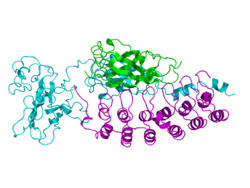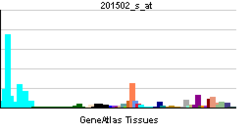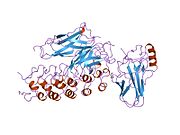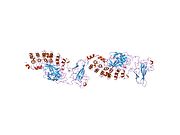- IκBα
-
IκBα (nuclear factor of kappa light polypeptide gene enhancer in B-cells inhibitor, alpha) is one member of a family of cellular proteins that function to inhibit the NF-κB transcription factor. IκBα inhibits NF-κB by masking the nuclear localization signals (NLS) of NF-κB proteins and keeping them sequestered in an inactive state in the cytoplasm.[1] In addition, IκBα blocks the ability of NF-κB transcription factors to bind to DNA, which is required for NF-κB's proper functioning.[2]
Contents
Disease linkage
The gene encoding the IκBα protein is mutated in some Hodgkin's lymphoma cells; such mutations inactivate the IκBα protein, thus causing NF-κB to be chronically active in the lymphoma tumor cells and this activity contributes to the malignant state of these tumor cells.[3]
Interactions
IκBα has been shown to interact with IKK2,[4][5][6] DYNLL1,[7] G3BP2,[8] BTRC,[9][10] Valosin-containing protein,[11] RELA,[5][10][12][13][14][15][16] NFKB1,[14][16] SUMO4,[17] P53,[18] RPS6KA1,[19] Heterogeneous nuclear ribonucleoprotein A1[14] and CHUK.[5][6][20][21]
References
- ^ Jacobs MD, Harrison SC (1998). "Structure of an IkappaBalpha/NF-kappaB complex". Cell 95 (6): 749–58. doi:10.1016/S0092-8674(00)81698-0. PMID 9865693.
- ^ Verma IM, Stevenson JK, Schwarz EM, Van Antwerp D, Miyamoto S (1995). "Rel/NF-kappa B/I kappa B family: intimate tales of association and dissociation". Genes Dev. 9 (22): 2723–35. doi:10.1101/gad.9.22.2723. PMID 7590248.
- ^ Cabannes E, Khan G, Aillet F, Jarrett RF, Hay RT (1999). "Mutations in the IkBa gene in Hodgkin's disease suggest a tumour suppressor role for IkappaBalpha". Oncogene 18 (20): 3063–70. doi:10.1038/sj.onc.1202893. PMID 10340377.
- ^ Mercurio, F; Murray B W, Shevchenko A, Bennett B L, Young D B, Li J W, Pascual G, Motiwala A, Zhu H, Mann M, Manning A M (Feb. 1999). "IkappaB kinase (IKK)-associated protein 1, a common component of the heterogeneous IKK complex". Mol. Cell. Biol. (UNITED STATES) 19 (2): 1526–38. ISSN 0270-7306. PMC 116081. PMID 9891086. http://www.pubmedcentral.nih.gov/articlerender.fcgi?tool=pmcentrez&artid=116081.
- ^ a b c Cohen, L; Henzel W J, Baeuerle P A (Sep. 1998). "IKAP is a scaffold protein of the IkappaB kinase complex". Nature (ENGLAND) 395 (6699): 292–6. doi:10.1038/26254. ISSN 0028-0836. PMID 9751059.
- ^ a b Woronicz, J D; Gao X, Cao Z, Rothe M, Goeddel D V (Oct. 1997). "IkappaB kinase-beta: NF-kappaB activation and complex formation with IkappaB kinase-alpha and NIK". Science (UNITED STATES) 278 (5339): 866–9. doi:10.1126/science.278.5339.866. ISSN 0036-8075. PMID 9346485.
- ^ Crépieux, P; Kwon H, Leclerc N, Spencer W, Richard S, Lin R, Hiscott J (Dec. 1997). "I kappaB alpha physically interacts with a cytoskeleton-associated protein through its signal response domain". Mol. Cell. Biol. (UNITED STATES) 17 (12): 7375–85. ISSN 0270-7306. PMC 232593. PMID 9372968. http://www.pubmedcentral.nih.gov/articlerender.fcgi?tool=pmcentrez&artid=232593.
- ^ Prigent, M; Barlat I, Langen H, Dargemont C (Nov. 2000). "IkappaBalpha and IkappaBalpha /NF-kappa B complexes are retained in the cytoplasm through interaction with a novel partner, RasGAP SH3-binding protein 2". J. Biol. Chem. (UNITED STATES) 275 (46): 36441–9. doi:10.1074/jbc.M004751200. ISSN 0021-9258. PMID 10969074.
- ^ Suzuki, H; Chiba T, Suzuki T, Fujita T, Ikenoue T, Omata M, Furuichi K, Shikama H, Tanaka K (Jan. 2000). "Homodimer of two F-box proteins betaTrCP1 or betaTrCP2 binds to IkappaBalpha for signal-dependent ubiquitination". J. Biol. Chem. (UNITED STATES) 275 (4): 2877–84. doi:10.1074/jbc.275.4.2877. ISSN 0021-9258. PMID 10644755.
- ^ a b Spencer, E; Jiang J, Chen Z J (Feb. 1999). "Signal-induced ubiquitination of IkappaBalpha by the F-box protein Slimb/beta-TrCP". Genes Dev. (UNITED STATES) 13 (3): 284–94. doi:10.1101/gad.13.3.284. ISSN 0890-9369. PMC 316434. PMID 9990853. http://www.pubmedcentral.nih.gov/articlerender.fcgi?tool=pmcentrez&artid=316434.
- ^ Dai, R M; Chen E, Longo D L, Gorbea C M, Li C C (Feb. 1998). "Involvement of valosin-containing protein, an ATPase Co-purified with IkappaBalpha and 26 S proteasome, in ubiquitin-proteasome-mediated degradation of IkappaBalpha". J. Biol. Chem. (UNITED STATES) 273 (6): 3562–73. doi:10.1074/jbc.273.6.3562. ISSN 0021-9258. PMID 9452483.
- ^ Chen Lf, Lf; Fischle W, Verdin E, Greene W C (Aug. 2001). "Duration of nuclear NF-kappaB action regulated by reversible acetylation". Science (United States) 293 (5535): 1653–7. doi:10.1126/science.1062374. ISSN 0036-8075. PMID 11533489.
- ^ Kiernan, Rosemary; Brès Vanessa, Ng Raymond W M, Coudart Marie-Pierre, El Messaoudi Selma, Sardet Claude, Jin Dong-Yan, Emiliani Stephane, Benkirane Monsef (Jan. 2003). "Post-activation turn-off of NF-kappa B-dependent transcription is regulated by acetylation of p65". J. Biol. Chem. (United States) 278 (4): 2758–66. doi:10.1074/jbc.M209572200. ISSN 0021-9258. PMID 12419806.
- ^ a b c Hay, D C; Kemp G D, Dargemont C, Hay R T (May. 2001). "Interaction between hnRNPA1 and IkappaBalpha is required for maximal activation of NF-kappaB-dependent transcription". Mol. Cell. Biol. (United States) 21 (10): 3482–90. doi:10.1128/MCB.21.10.3482-3490.2001. ISSN 0270-7306. PMC 100270. PMID 11313474. http://www.pubmedcentral.nih.gov/articlerender.fcgi?tool=pmcentrez&artid=100270.
- ^ Hansen, S K; Baeuerle P A, Blasi F (Apr. 1994). "Purification, reconstitution, and I kappa B association of the c-Rel-p65 (RelA) complex, a strong activator of transcription". Mol. Cell. Biol. (UNITED STATES) 14 (4): 2593–603. ISSN 0270-7306. PMC 358627. PMID 8139561. http://www.pubmedcentral.nih.gov/articlerender.fcgi?tool=pmcentrez&artid=358627.
- ^ a b Malek, S; Huxford T, Ghosh G (Sep. 1998). "Ikappa Balpha functions through direct contacts with the nuclear localization signals and the DNA binding sequences of NF-kappaB". J. Biol. Chem. (UNITED STATES) 273 (39): 25427–35. doi:10.1074/jbc.273.39.25427. ISSN 0021-9258. PMID 9738011.
- ^ Guo, Dehuang; Li Manyu, Zhang Yan, Yang Ping, Eckenrode Sarah, Hopkins Diane, Zheng Weipeng, Purohit Sharad, Podolsky Robert H, Muir Andrew, Wang Jinzhao, Dong Zheng, Brusko Todd, Atkinson Mark, Pozzilli Paolo, Zeidler Adina, Raffel Leslie J, Jacob Chaim O, Park Yongsoo, Serrano-Rios Manuel, Larrad Maria T Martinez, Zhang Zixin, Garchon Henri-Jean, Bach Jean-Francois, Rotter Jerome I, She Jin-Xiong, Wang Cong-Yi (Aug. 2004). "A functional variant of SUMO4, a new I kappa B alpha modifier, is associated with type 1 diabetes". Nat. Genet. (United States) 36 (8): 837–41. doi:10.1038/ng1391. ISSN 1061-4036. PMID 15247916.
- ^ Chang, Nan-Shan (Mar. 2002). "The non-ankyrin C terminus of Ikappa Balpha physically interacts with p53 in vivo and dissociates in response to apoptotic stress, hypoxia, DNA damage, and transforming growth factor-beta 1-mediated growth suppression". J. Biol. Chem. (United States) 277 (12): 10323–31. doi:10.1074/jbc.M106607200. ISSN 0021-9258. PMID 11799106.
- ^ Schouten, G J; Vertegaal A C, Whiteside S T, Israël A, Toebes M, Dorsman J C, van der Eb A J, Zantema A (Jun. 1997). "IkappaB alpha is a target for the mitogen-activated 90 kDa ribosomal S6 kinase". EMBO J. (ENGLAND) 16 (11): 3133–44. doi:10.1093/emboj/16.11.3133. ISSN 0261-4189. PMC 1169932. PMID 9214631. http://www.pubmedcentral.nih.gov/articlerender.fcgi?tool=pmcentrez&artid=1169932.
- ^ DiDonato, J A; Hayakawa M, Rothwarf D M, Zandi E, Karin M (Aug. 1997). "A cytokine-responsive IkappaB kinase that activates the transcription factor NF-kappaB". Nature (ENGLAND) 388 (6642): 548–54. doi:10.1038/41493. ISSN 0028-0836. PMID 9252186.
- ^ Ninomiya-Tsuji, J; Kishimoto K, Hiyama A, Inoue J, Cao Z, Matsumoto K (Mar. 1999). "The kinase TAK1 can activate the NIK-I kappaB as well as the MAP kinase cascade in the IL-1 signalling pathway". Nature (ENGLAND) 398 (6724): 252–6. doi:10.1038/18465. ISSN 0028-0836. PMID 10094049.
Further reading
- Roulston A, Lin R, Beauparlant P, et al. (1995). "Regulation of human immunodeficiency virus type 1 and cytokine gene expression in myeloid cells by NF-kappa B/Rel transcription factors.". Microbiol. Rev. 59 (3): 481–505. PMC 239370. PMID 7565415. http://www.pubmedcentral.nih.gov/articlerender.fcgi?tool=pmcentrez&artid=239370.
- Hay RT, Vuillard L, Desterro JM, Rodriguez MS (2000). "Control of NF-kappa B transcriptional activation by signal induced proteolysis of I kappa B alpha.". Philos. Trans. R. Soc. Lond., B, Biol. Sci. 354 (1389): 1601–9. doi:10.1098/rstb.1999.0504. PMC 1692667. PMID 10582246. http://www.pubmedcentral.nih.gov/articlerender.fcgi?tool=pmcentrez&artid=1692667.
- Muthumani K, Desai BM, Hwang DS, et al. (2004). "HIV-1 Vpr and anti-inflammatory activity.". DNA Cell Biol. 23 (4): 239–47. doi:10.1089/104454904773819824. PMID 15142381.
- Caraglia M, Marra M, Pelaia G, et al. (2005). "Alpha-interferon and its effects on signal transduction pathways.". J. Cell. Physiol. 202 (2): 323–35. doi:10.1002/jcp.20137. PMID 15389589.
- Le Rouzic E, Benichou S (2006). "The Vpr protein from HIV-1: distinct roles along the viral life cycle.". Retrovirology 2 (1): 11. doi:10.1186/1742-4690-2-11. PMC 554975. PMID 15725353. http://www.pubmedcentral.nih.gov/articlerender.fcgi?tool=pmcentrez&artid=554975.
- Zhao RY, Bukrinsky M, Elder RT (2005). "HIV-1 viral protein R (Vpr) & host cellular responses.". Indian J. Med. Res. 121 (4): 270–86. PMID 15817944.
- Sun XF, Zhang H (2007). "NFKB and NFKBI polymorphisms in relation to susceptibility of tumour and other diseases.". Histol. Histopathol. 22 (12): 1387–98. PMID 17701919.
PDB gallery External links
Categories:- Human proteins
- Transcription factors
- Chromosome 14 gene stubs
Wikimedia Foundation. 2010.




